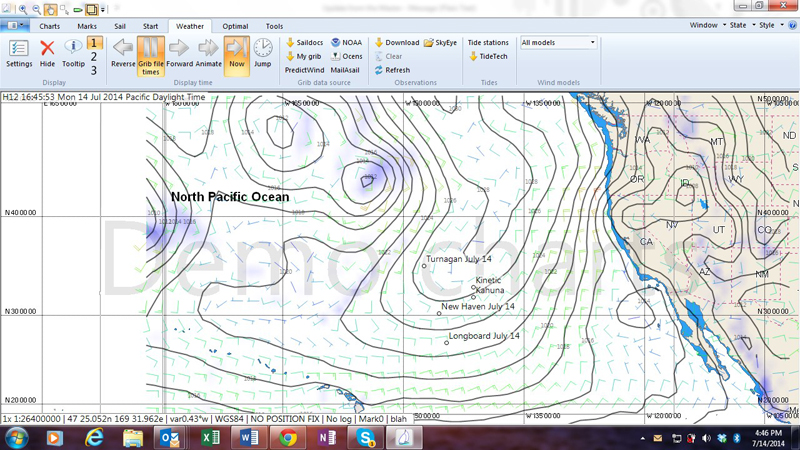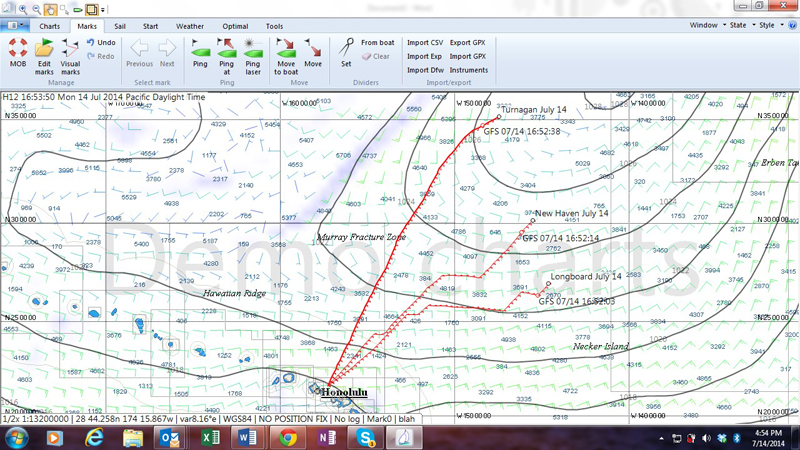Brad Baker of Swiftsure Yachts continues to track the Vic-Maui fleet and analyze – and even predict! Thanks, Brad. -KH
After three days of toughing it out in light winds, the fleet is starting to see some decent speeds. Having been caught in the grips of the Pacific high myself, I can tell you that it’s not fun, especially if your competitors are making better speed, perhaps erasing a lead you had. When the wind drops below 5 knots things can get noisy. The mainsail doesn’t have enough pressure in it to keep it from “slatting” back and forth. This can cause a loud smack as it fills from side to side. The slatting can be violent enough to cause damage to sail slides and attachment points. What should be ideal sleeping conditions gets interrupted by the loud pop as the main fills. The same holds true for the headsail or spinnaker. With the leftover ocean swell a spinnaker can be near impossible to fly in these conditions. Sometimes the fastest combination is to put up a #3 or #4 and secure both sheets, making for an efficient sail no matter which way the boat is currently rolling. You know it’s bad when the albatross decides it’s not worth flying around the boat and lands right next to you circling the boat under paddle feet power rather than wing power.
Click on any image to enlarge.



Well for the Vic-Maui fleet that is all pretty much over. The Pacific high, which had weakened and moved over the fleet, is in the process of repositioning more to the North. A look at the race tracker show speeds ranging from 6 to 9 knots.
Things have played out more or less as I expected. As the wind lightened the fleet fanned out as navigators made their moves. The J-160 Jam decided to stay east and head south. Longboard, and to a lesser extent New Haven, kept more of a SSW course. Many of the B and C class boats stayed on a more southerly track as well, but suffered a bit more than Longboard and New Haven and weren’t able to get out of the grip of the high. Finally there is a contingent of 2 Class B boats and 3 in Class C that made a move to the west.
So what does this all mean? Well, I will go on record saying that I favored the westward route. From day one the routing software consistently pointed toward the westward track as the fastest course for virtually the entire fleet. The boats that went west minimized the time spent in the lightest of airs. It was counter-intuitive to sail directly towards the coming light winds, but for most the fleet, there was no avoiding those winds anyway. You may notice that the five westerly boats are now sailing upwind, which is bad right? Well, when the wind is light going upwind can actually provide faster speeds as the apparent wind increases. Furthermore, being in some wind is better than being in no wind. Now that the wind has filled in across the fleet, the folks going upwind will have slower top boat speeds in the short term. The good news for them is the wind is going to shift. In perhaps a day they will find themselves beam reaching and the speeds will come up. As time passes they will get even more lifted and will be able to set spinnakers, sailing on a hot angle all the way to the finish. By setting themselves up west they have put themselves in the best position to take advantage of the coming wind shift and will sail a faster more direct route to the Mai Tais.
I want to preface the next bit of analysis with this. It’s easy for us to sit on the sideline and make judgments about what the boats on the water should do. There is a lot we do not and cannot know. The winds are constantly shifting, conditions are in flux and there could very well be conditions like, opposing wave patterns, that prevent or make unreasonable a strategy that seems obvious to us on land. Keep this in mind that as I voice my opinions it could be a whole load of crap, because I’m not out there dealing with what the competitors have had to deal with. That said I’m going to go ahead and pass judgment anyway.
Well the race isn’t over yet but there are some clear winners and losers thus far. In class B, String Theory has turned an over 100 mile deficit into nearly a lead boat for boat over Kahuna. On top of this, String Theory now has a 90-mile lead over sister ship Kinetic. Alegria, also in class B, also went west and is about 30 miles behind String Theory. These two class B boats will have the advantage of a stronger position to bring them home. I believe these two boats will lead class B on corrected and look very strong for the overall corrected prize. Of the two I favor String Theory to hold on to her lead for the win, mostly because I sold John the boat!
In class C it’s a three boat horse race between Turnagain who has moved into a comfortable lead, followed by Passerpartout and Turricum. Passerpartout has been haunted by boat speed problems over the last couple of days. At times the tracker showed them pointing in the opposite direction with virtually no boat speed and on the whole have been consistently about two knots slower than those around them. Hopefully they will get these issues worked out, as they have dropped to second in class and are quickly being passed by 3rd place Turricum. Positioned well to the west of the rest of the fleet, I feel that it will be one of these three class C boats that will come up the victor in this class. Though Turnagain has the lead, there is plenty of race track left and it could be any of these three pulling off the class win.
I spent time with the guys on the J-160 Jam, helping with preparation, mostly giving pointers on the use of Expedition software. It pains me to write this, but it looks like their choice to stay east will not work out. They have spent probably the most time in the lightest winds and now have a very deep hole to dig themselves out of. On top of that they are almost dead upwind of Hawaii and will have to sail extra distance, making gybes, to sail the optimum course. In class A the real race is between Longboard and New Haven. As a side note, I think New Haven had an opportunity to put the race in the bag during the light air transition. Had New Haven chosen to make more westing, I believe they would have had a position insurmountable by Longboard (reference my preface above, I could also be full of crap!). The gap between these two boats did close during the lighter air. In the end, with the rubber band effect, Longboard has managed to maintain her lead over New Haven, and is currently 63 miles closer to the finish. 63 miles is more than enough to save the 5 and half hours that Longboard owes New Haven……..right? Taking a closer look, New Haven does have some separation to the west. This means they will be able to sail a more direct line to the finish. They may not have to gybe at all. On the other hand Longboard will most definitely have to gybe. As a matter of fact, during the time I started to write this, Longboard has gybed and are currently sailing on starboard. As the two boats converge Longboard’s lead will all but vanish. Longboard needs to out boat speed New Haven if they are to win class A on corrected time. We will get a better idea as the two boats converge, but I suspect the lead Longboard truly has is maybe 10 miles. To win they will need a cushion of 50 miles give or take. This means they will need to add 40 miles over New Haven over the next 3 days or so. That’s about 13 miles a day. If I’m right, this means Longboard will need to average about .5 knots faster VMG to Hawaii until the finish. Who will come out on top? I’m not prepared to make that call. This is more exciting than the World Cup!
4 comments
Great summary, I am predicting Longboard. At the crossing they are still 50 miles ahead and on the same gybe to the finish the will average at least a knot better boat speed over New Haven with out breaking a sweat. That boat is a rocket shop in 15-20 knots of breeze.
Thanks for comment! Please help make sure folks hear about Brad’s most recent post. For some reason the throngs of people who checked Brad’s first two posts aren’t hearing about this one. Thanks! It’ll be fun to see how this plays out. Having raced against Longboard, I fully agree that it’s a rocket ship.
Thanks for your great blog
Hi Nancy, thanks for noticing. Please spread the word that we’re here to help promote boating of all types, and we’ll welcome all the help we can get with ideas, photos and stories.